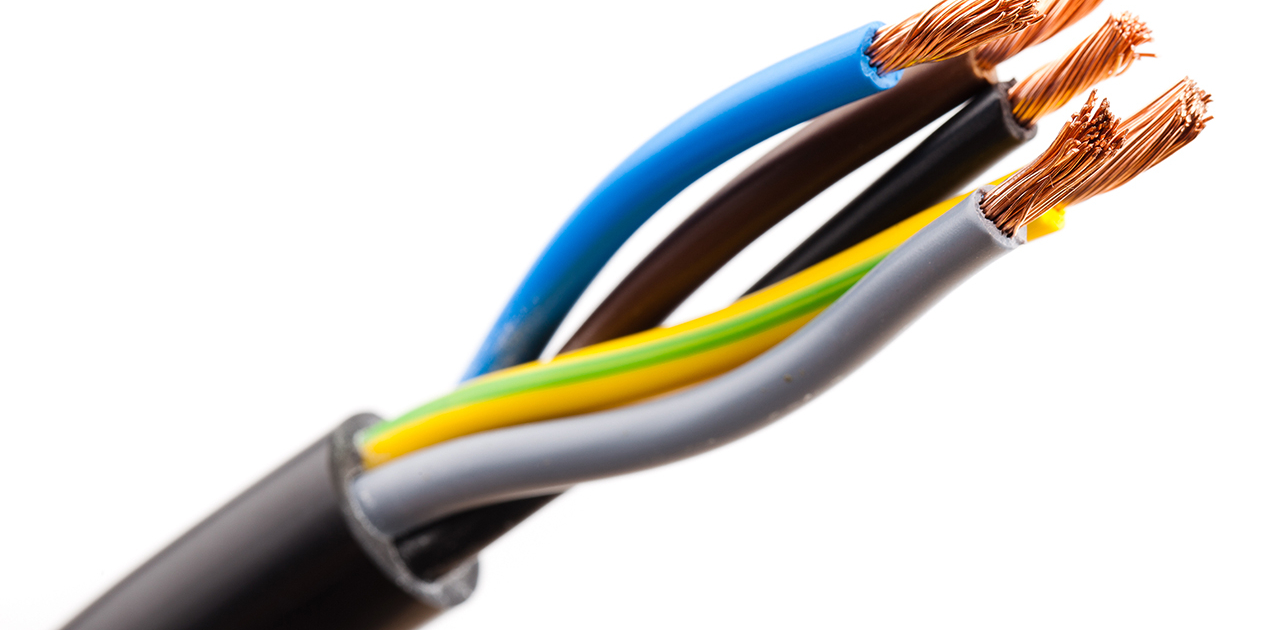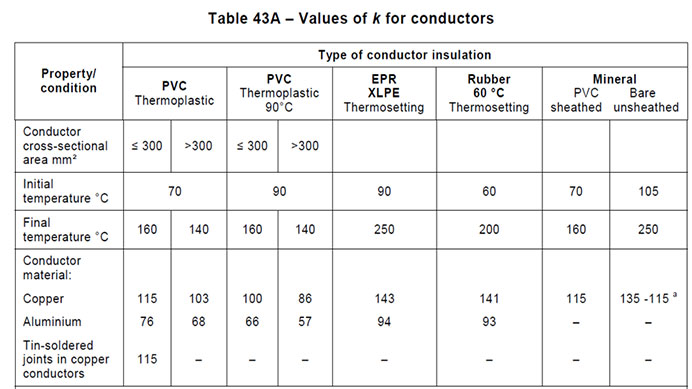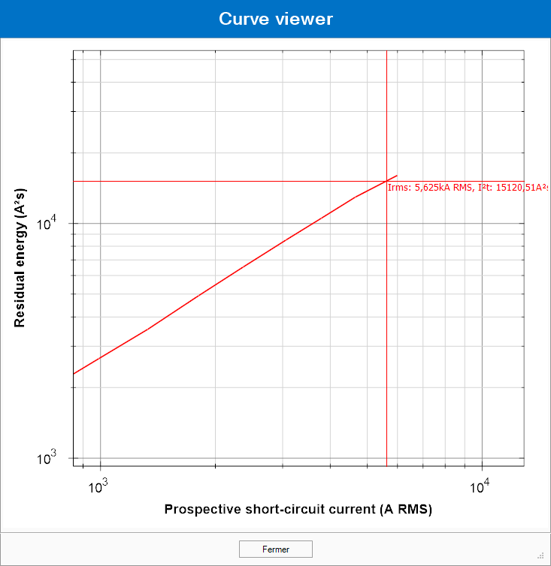Among the intrinsic characteristics of a cable or an electrical conductor, there are two values which are essential for its sizing:
• The maximum temperature of the core in steady-state which allows calculating the ampacity.
• The maximum temperature of the core in short circuit, temperature beyond which the deterioration of the insulation begins.
For standardized cables, these values are imposed by the standard, for example, 90° C and 250° C respectively for cables insulated with EPR/XLPE.
It is, therefore, necessary to check that the passage of the short-circuit current (Ik) during the disconnection time (t) will not bring the core of the cable beyond its maximum temperature.
For a disconnection time of fewer than five seconds (hence the maximum imposed in the installation standards), the heating is considered adiabatic, that is to say, that it is accepted that the heat produced stays at the core of the conductor and does not have time to dissipate in the other elements of the cable.

In this hypothesis, the thermal stress borne by the conductors is calculated by the formula:
Let-through energy = Ik2 × t in A2s
The thermal stress admissible by the conductor is calculated by the formula k2 × S2 in which:
• S is the cross-section of the conductor in mm2
• k is a factor taking into account the resistivity, the temperature coefficient and the resistance to heating of the conductor material, as well as the initial temperatures (maximum core temperature in steady-state for a charged conductor or a PE incorporated in the cable, or ambient temperature for a separate PE) and final (maximum temperature of the short-circuited core) of the conductor.
It should, therefore, be verified that, in all cases of a short circuit, the relationship is verified:
Ik2 × t < k2 × S2
To facilitate the calculations, it is possible to use the tables giving the values of k in the usual cases, as in the following example taken from document IEC 60364-4-43:

Thermal stress verification with elec calc
The elec calc™ software calculates the maximum let-through energy on all the conductors and compares it to their thermal withstand value (according to the formula k²×S²). This verification applies to the phases but also to the neutral and to the PE. If this condition is not met a thermal stress error is displayed on the cable.
How to solve a thermal stress problem?
In the event of a thermal stress problem, it is always possible to oversize the cross-section of the conductors, thus increasing their admissible thermal stress. However, other possibilities can overcome this increase in section.
Use of fuses: the melting time of a fuse is generally much shorter than the operating time of a circuit breaker for high short circuit currents. There is, therefore, a natural limitation of the let-through energy. Note that in the event of fuse protection, the maximum energy can take place during the minimum short circuit because the melting time may be longer. It is, therefore, necessary to check the cable withstand for all types of short circuit current.
Use of limiting circuit-breakers: certain ranges of equipment are designed to prevent the establishment of fault current, by letting only a current of limited intensity. The limitation performance of a circuit-breaker is given by the manufacturer in the form of limitation curves:
• The curve representing the peak value of the limited current as a function of the RMS value of the alternating component of the prospective fault current (useful for checking electrodynamic stresses)
• The curve representing the value of the limited let through energy as a function of the RMS value of the alternating component of the prospective fault current. It is this limited value which must be compared with the admissible thermal stress of the conductors.
Analysis of limitation curves with the elec calc multi-manufacturer catalog
The multi-manufacturer catalog from elec calc™ manages the limitation curves for the various protections. As soon as a reference with a limitation is associated with a protection device, the software is able to recover the limited let through energy associated with the prospective short circuit current. It should be noted that most miniature circuit breakers have limitation capacities, making it possible to solve the thermal stress problems in small section cables which are most affected by thermal stress problems.
EXAMPLE:
My installation includes a lighting circuit with a U1000R2V-3G2.5 cable protected by a 16 A curve C circuit breaker.
The maximum short circuit current at the cable is 5.63 kA and the protection tripping time 10 ms. The let-through energy is, therefore: Ik² × t = 5.63² × 0.01 or 316 969 A²s
The thermal withstand of my cable is: k² × S² = 143² × 2.5² or 127 806 A²s
Check Ik² × t > k² × S² => problem of thermal stress on the cable: in the event of a short circuit the cable will be damaged.
Fuse case:
If I replace the circuit breaker with a 16 A gG fuse, the melting time is 4.10-5 s. The maximum let-through energy is, therefore: Ik² × t = 5.63² × 0.00004 or 1268 A²s There is, therefore, no problem of thermal stress on the cable. In our case, we also checked that it is the maximum short circuit current that gives the maximum energy.
Integration of a circuit breaker reference with a limitation:
I now include a manufacturer reference on my protection. The software will, therefore, be able to read from the energy-limiting curve supplied by the manufacturer the let-through energy for a short circuit current of 5.63 kA:

In our case the residual energy is 15 120 A²s. It is lower than the conductor thermal withstand. So, we no longer have a thermal stress problem on the cable.
Go further with elec calc for the calculation of through energy
Taking into account the DC component: in the formulas mentioned above, we have considered that the value of Ik is the RMS value of the AC component of the prospective fault current. If we want to be more accurate, we must take into account the DC component of the fault current. The influence of this continuous component is especially noticeable when the point of fault is close to the sources. It depends on the disconnection time and the value of the X / R ratio of the circuit at the fault point. It is then advisable to calculate an equivalent thermal current which replaces in the formulas the current Ik.
elec calc™ takes into account the influence of this continuous component when the standard used requires it.
Multiple sources: a fault can be supplied by several sources, each contributing to the short circuit current. The protections associated with these different sources may not react at the same time to the short circuit current that they generate. The accurate calculation of the let-through energy must, therefore, integrate a chronological cumulation of the energies produced by each source.
This is what elec calc™ software does in order to get as close as possible to the real phenomenon.
